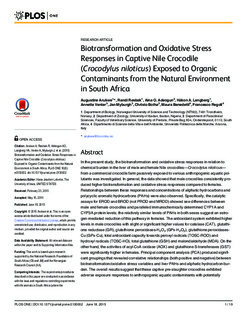| dc.contributor.author | Arukwe, Augustine | |
| dc.contributor.author | Røsbak, Randi | |
| dc.contributor.author | Adeogun, Aina O | |
| dc.contributor.author | Langberg, Håkon A | |
| dc.contributor.author | Venter, Annette | |
| dc.contributor.author | Myburgh, Jan | |
| dc.contributor.author | Botha, Christo | |
| dc.contributor.author | Benedetti, Maura | |
| dc.contributor.author | Regoli, Francesco | |
| dc.date.accessioned | 2015-09-01T10:34:36Z | |
| dc.date.accessioned | 2015-09-02T13:39:20Z | |
| dc.date.available | 2015-09-01T10:34:36Z | |
| dc.date.available | 2015-09-02T13:39:20Z | |
| dc.date.issued | 2015 | |
| dc.identifier.citation | PLoS ONE 2015 | nb_NO |
| dc.identifier.issn | 1932-6203 | |
| dc.identifier.uri | http://hdl.handle.net/11250/298500 | |
| dc.description.abstract | In the present study, the biotransformation and oxidative stress responses in relation to
chemical burden in the liver of male and female Nile crocodiles—Crocodylus niloticus—
from a commercial crocodile farm passively exposed to various anthropogenic aquatic pollutants
was investigated. In general, the data showed that male crocodiles consistently produced
higher biotransformation and oxidative stress responses compared to females.
Relationships between these responses and concentrations of aliphatic hydrocarbons and
polycyclic aromatic hydrocarbons (PAHs) were also observed. Specifically, the catalytic
assays for EROD and BROD (not PROD and MROD) showed sex-differences between
male and female crocodiles and paralleled immunochemically determined CYP1A and
CYP3A protein levels; the relatively similar levels of PAHs in both sexes suggest an estrogen-
mediated reduction of this pathway in females. The antioxidant system exhibited higher
levels in male crocodiles with slight or significant higher values for catalase (CAT), glutathione
reductase (GR), glutathione peroxidases-H2O2 (GPx-H2O2), glutathione peroxidases-
Cu (GPx-Cu), total antioxidant capacity towards peroxyl radicals (TOSC-ROO) and
hydroxyl radicals (TOSC-HO), total glutathione (GSH) and malondialdehyde (MDA). On the
other hand, the activities of acyl-CoA oxidase (AOX) and glutathione S-transferases (GST)
were significantly higher in females. Principal component analysis (PCA) produced significant
groupings that revealed correlative relationships (both positive and negative) between
biotransformation/oxidative stress variables and liver PAHs and aliphatic hydrocarbon burden.
The overall results suggest that these captive pre-slaughter crocodiles exhibited
adverse exposure responses to anthropogenic aquatic contaminants with potentially relevant effects on key cellular pathways, and these responses may be established as relevant
species biomarkers of exposure and effects in this endangered species. | nb_NO |
| dc.language.iso | eng | nb_NO |
| dc.publisher | Public Library of Science | nb_NO |
| dc.title | Biotransformation and Oxidative Stress Responses in Captive Nile Crocodile (Crocodylus niloticus) Exposed to Organic Contaminants from the Natural Environment in South Africa | nb_NO |
| dc.type | Journal article | nb_NO |
| dc.type | Peer reviewed | en_GB |
| dc.date.updated | 2015-09-01T10:34:36Z | |
| dc.source.journal | PLoS ONE | nb_NO |
| dc.identifier.doi | 10.1371/journal.pone.0130002 | |
| dc.identifier.cristin | 1261213 | |
| dc.description.localcode | © 2015 Arukwe et al. This is an open access article distributed under the terms of the Creative Commons Attribution License, which permits unrestricted use, distribution, and reproduction in any medium, provided the original author and source are credited | nb_NO |
